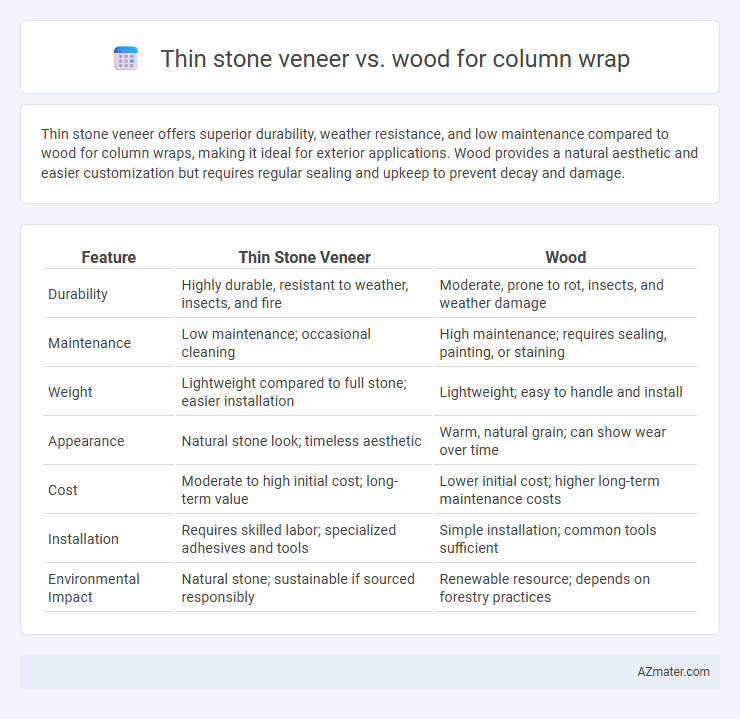Thin stone veneer offers superior durability, weather resistance, and low maintenance compared to wood for column wraps, making it ideal for exterior applications. Wood provides a natural aesthetic and easier customization but requires regular sealing and upkeep to prevent decay and damage.
Table of Comparison
| Feature | Thin Stone Veneer | Wood |
|---|---|---|
| Durability | Highly durable, resistant to weather, insects, and fire | Moderate, prone to rot, insects, and weather damage |
| Maintenance | Low maintenance; occasional cleaning | High maintenance; requires sealing, painting, or staining |
| Weight | Lightweight compared to full stone; easier installation | Lightweight; easy to handle and install |
| Appearance | Natural stone look; timeless aesthetic | Warm, natural grain; can show wear over time |
| Cost | Moderate to high initial cost; long-term value | Lower initial cost; higher long-term maintenance costs |
| Installation | Requires skilled labor; specialized adhesives and tools | Simple installation; common tools sufficient |
| Environmental Impact | Natural stone; sustainable if sourced responsibly | Renewable resource; depends on forestry practices |
Introduction to Column Wrap Materials
Thin stone veneer offers a durable, weather-resistant option for column wraps, providing the aesthetic appeal of natural stone without the heavy weight or extensive installation requirements. Wood column wraps create a warm, traditional look and can be customized with paint or stain, but they require regular maintenance to prevent rot, insect damage, and weathering. Choosing between thin stone veneer and wood depends on factors like desired appearance, durability needs, installation effort, and long-term upkeep.
Overview of Thin Stone Veneer
Thin stone veneer is a durable, lightweight cladding option ideal for column wraps, offering the natural aesthetic of full stone without the heavy weight and high cost. Made from real stone or manufactured materials, it provides excellent weather resistance and requires minimal maintenance. Compared to wood, thin stone veneer enhances structural longevity and adds a timeless, elegant look to architectural designs.
Overview of Wood Column Wraps
Wood column wraps offer a natural, warm aesthetic, often crafted from durable hardwoods like cedar or oak that resist weathering and decay. They provide excellent insulation properties and can be custom-milled to fit various column sizes and architectural styles, enhancing curb appeal. Maintenance involves periodic sealing or staining to preserve their appearance and protect against moisture damage.
Aesthetic Appeal: Stone Veneer vs Wood
Thin stone veneer offers a timeless, natural aesthetic with rich textures and color variations that enhance architectural elegance, making it ideal for sophisticated column wraps. Wood provides warmth and organic charm with its diverse grain patterns and finishes but requires regular maintenance to prevent weathering and preserve its visual appeal. Stone veneer generally maintains its appearance longer under varying weather conditions, giving it a durable edge in aesthetic longevity compared to wood.
Durability and Longevity Comparison
Thin stone veneer offers superior durability and longevity compared to wood for column wraps, as it resists moisture, pests, and weathering without warping or rotting. Stone veneer can last several decades with minimal maintenance, maintaining its structural integrity and appearance in harsh climates. Wood column wraps require regular sealing and treatment to prevent decay, making them less durable and more prone to damage over time.
Installation Process and Considerations
Thin stone veneer offers durability and a natural aesthetic with a relatively straightforward installation process involving mortar application and precise cutting to fit the column's dimensions, requiring a solid substrate for optimal adhesion. Wood column wraps demand careful measurement, cutting, and fastening, with considerations for potential warping, moisture resistance, and maintenance to ensure longevity and stability. Choosing between thin stone veneer and wood depends on the building's architectural style, environmental exposure, and the desired level of upkeep.
Maintenance Requirements for Each Material
Thin stone veneer offers low maintenance with its durable, weather-resistant properties requiring only occasional cleaning and minimal repairs. Wood column wraps demand regular sealing or painting to prevent rot, warping, and insect damage, increasing long-term upkeep costs. Choosing thin stone veneer significantly reduces time and effort spent on maintenance compared to wood.
Cost Analysis: Stone Veneer vs Wood
Thin stone veneer for column wraps generally incurs higher initial material costs compared to wood, with prices typically ranging from $6 to $12 per square foot for stone, while wood costs can be between $3 and $7 per square foot. Installation expenses for stone veneer are also usually greater due to the need for specialized labor and masonry skills, whereas wood wraps offer more straightforward and less labor-intensive installation, reducing total project costs. Over time, wood may require more maintenance and replacement, impacting long-term costs, whereas stone veneer provides greater durability and lower upkeep expenses, potentially offering better value despite the higher upfront investment.
Environmental Impact and Sustainability
Thin stone veneer offers a more sustainable option for column wraps due to its durability, low maintenance, and natural material composition that reduces the need for frequent replacement and resource consumption. Wood column wraps, often sourced from timber, contribute to deforestation and require treatments that may introduce harmful chemicals, impacting environmental health. Choosing thin stone veneer supports long-term environmental preservation by minimizing waste and utilizing eco-friendly quarrying practices.
Choosing the Right Material for Your Project
Thin stone veneer offers durability, weather resistance, and a natural stone appearance ideal for outdoor column wraps, while wood provides warmth and versatility with easier customization but requires regular maintenance to prevent rot and insect damage. Selecting the right material depends on project location, budget, desired aesthetic, and maintenance willingness; thin stone veneer suits long-lasting, low-maintenance applications, whereas wood is preferred for classic or rustic designs where frequent upkeep is manageable. Consider environmental exposure, installation complexity, and lifecycle costs to ensure the material aligns with overall project goals and sustainability preferences.

Infographic: Thin stone veneer vs Wood for Column wrap
 azmater.com
azmater.com